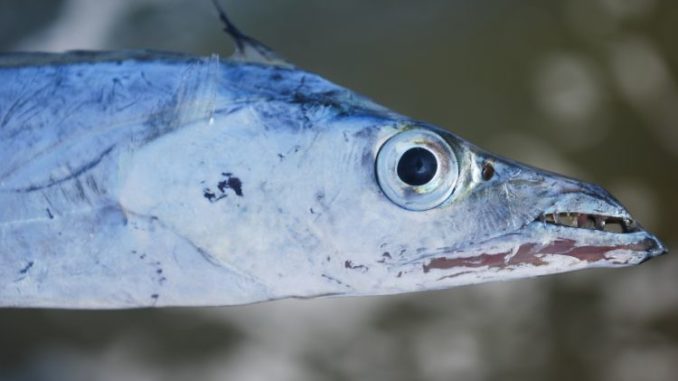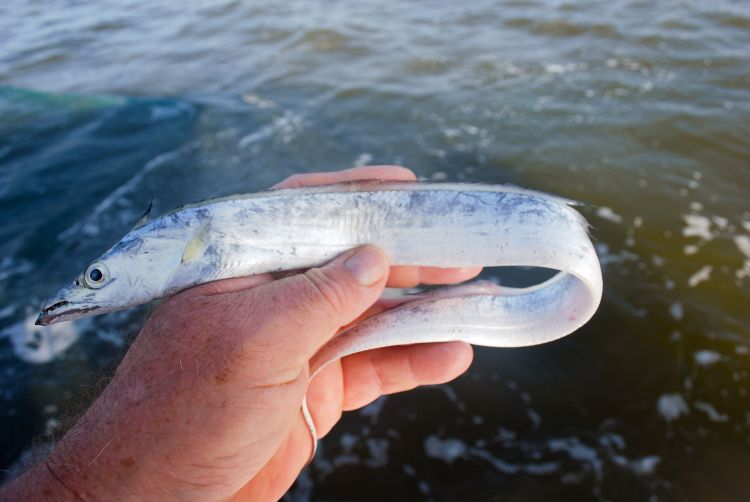
Here’s the rundown on ribbonfish
We don’t call them cutlassfish.
Most Louisiana sport fishermen call them ribbonfish. Commercial shrimpers dub them silver eels, and consider them a minor nuisance for their habit of getting halfway through the meshes of their trawls’ bags and dying there.
Elsewhere in the world, where they are very commonly chased by commercial fishermen for human food, they are invariably called hairtails.
The Atlantic cutlassfish, Trichiurus lepturus, was certainly descriptively named by the scientist who chose the name: Trichiurus means “hair tail” and lepturus means “slender tail,” both in Greek.
Eight members of the cutlassfish family are found off of U.S. coasts: four in the Atlantic and four in the Pacific.
Of the Atlantic species, the North Atlantic frostfish is found only in the north Atlantic, as its name implies.
The channel scabbordfish and the crested scabbordfish are found in the Gulf of Mexico, but only in waters deeper than 300 feet.
Our hero, on the other hand, isn’t choosy about where it lives.
Not only is it found in the Gulf of Mexico, but it ranges the entire Atlantic coast of North and South America and the Pacific coast from Baja California south to Chile. It is found in southern Europe’s Atlantic waters, the Mediterranean Sea, the entire coast of Africa, and every coast in Asia, Australia, New Zealand, and the Pacific islands.
In short, they are everywhere.

And where they occur, they are not depth-limited, being found in inshore waters only a few feet deep out to offshore waters 1,900 feet deep.
Every member of the family carries a resemblance to the others. They all have long, slender bodies flattened side-to-side like a ribbon (hence the nickname “ribbonfish”) and are silvery in color.
All are also missing scales, pelvic fins (the pair of fins by the anus) and tail fins. The anal (belly) fin is so small as to be unnoticeable.
What they do have is a spineless dorsal fin that extends the length of the body from just behind the head to the tip of the hair-like tail.
Our hero is so silver in color as to be metallic, and it comes equipped with a large mouthful of scary-looking fangs that it knows how to use.
Adult Atlantic cutlassfish are predators. Rather than chase down their prey, they suspend their bodies vertically in the water with their jaws pointing upward. They remain motionless until a small, unsuspecting fish, squid or shrimp passes near.
With a quick, upward lunge that can carry it several feet out of the water, it grabs its prey.
In Gulf waters, half of all finfish consumed are anchovies.
During daylight hours, young cutlassfish spend much of their time near the sea floor, rising to near the surface at night to feed on small shrimp-like krill and small fish.
Surface waters are a perilous place for the youngsters, for adult cutlassfish are noted to mercilessly cannibalize their own young.
In the Gulf of Mexico, the smallest sexually mature cutlassfish found were 15.5 inches for males and 14 inches for females. Ready-to-spawn females were found from April through October, and they were found at all depths sampled.
Eggs produced ranged from 5,000 from a 16.8-inch, 1.3-ounce fish to 42,100 from a 36.8-inch, 18.3-ounce fish.
It is unknown how many times they spawn during a season.
Atlantic cutlassfish can grow to well over 7 feet long. The IGFA world record for a sport-caught fish is 8 pounds, 1 ounce, although commercial fishermen have caught well-documented specimens over 11 pounds in weight.
They live to as be as old as 15 years in the wild.
They are not popular as a sport or commercial food fish in the United States, where they are used most often in bluewater troll fisheries or as cut bait.
Something I have never seen anywhere else except in Calcasieu Lake is speckled trout there avidly pursuing cutlassfish, even jumping out of water to run them down.
Elsewhere in the world, cutlassfish are enormously popular, ranking as the earth’s sixth most-important fishery.
China dominates with 92 percent of the catch. Other countries with significant catches are South Korea, Japan, and Pakistan. Lesser catches are made by Portugal and Brazil.
Almost always sold as “sword fish” because of their saber-like shape, their flesh is described as firm yet tender after cooking, with a moderate level of “fishiness” to the smell and low oiliness.
Cutlassfish are noted to be fairly easy to debone.
In Korea, they are fried or grilled. In Japan, they are most popular grilled or raw, as sashimi. In Portugal and Brazil, they are most often grilled or fried.


